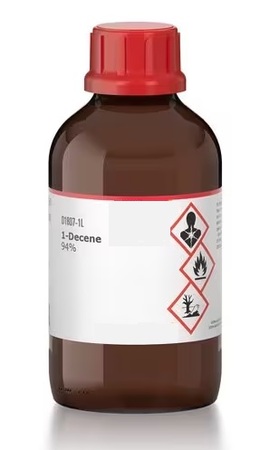
The 1-decene market is experiencing steady growth, driven by its versatile applications across various industries. The market revenue has been steadily increasing, with a promising CAGR of 6.5% during the forecast period of 2025 to 2033. 1-Decene, also known as decene-1, is an alpha-olefin hydrocarbon with ten carbon atoms. It is primarily derived from the oligomerization of ethylene or through the Fischer-Tropsch synthesis process. The market for 1-Decene is witnessing growth due to its wide range of applications. It serves as a crucial building block in the production of various chemical compounds and polymers. 1-Decene is extensively used in the production of linear low-density polyethylene (LLDPE), which finds applications in packaging, films, and coatings. The demand for LLDPE is increasing due to its superior properties such as flexibility, impact resistance, and chemical resistance. This drives the growth of the 1-Decene market. Moreover, 1-Decene is also utilized in the manufacturing of synthetic lubricants and surfactants. Synthetic lubricants offer superior performance, higher temperature stability, and improved efficiency compared to conventional lubricants. The expanding automotive and industrial sectors are driving the demand for synthetic lubricants, thereby bolstering the growth of the 1-Decene market. Additionally, 1-Decene finds application in the production of detergent alcohols, which are essential components of various cleaning and personal care products. The growing awareness regarding hygiene and the increasing demand for personal care products are propelling the demand for detergent alcohol, consequently driving the market for 1-Decene. The market for 1-Decene is also influenced by factors such as technological advancements, research and development activities, and the growing demand for sustainable and eco-friendly products. Manufacturers are focusing on developing efficient and cost-effective production processes to meet the rising demand for 1-Decene and its derivatives.

Growing Demand for Polyethylene and Polyalphaolefins (PAOs)
The 1-Decene market is driven by the increasing demand for polyethylene and polyalphaolefins (PAOs). Polyethylene, particularly linear low-density polyethylene (LLDPE), is widely used in various industries such as packaging, automotive, and construction. LLDPE offers excellent flexibility, impact resistance, and chemical resistance, making it suitable for applications such as films, coatings, and molded products. The rising global population and increasing consumer demand for packaged goods are key factors contributing to the growth of the polyethylene market, thereby driving the demand for 1-Decene as a feedstock. According to the International Energy Agency (IEA), the global demand for polyethylene is expected to grow at an average annual rate of 3.8% between 2021 and 2026. Furthermore, polyalphaolefins (PAOs) derived from 1-Decene are widely used as synthetic lubricants due to their superior performance characteristics. PAOs offer better thermal stability, oxidation resistance, and viscosity index compared to conventional mineral oils. The increasing demand for high-performance lubricants in automotive, industrial, and aerospace applications is driving the growth of the PAO market, subsequently boosting the demand for 1-Decene.
Growing Demand for Detergent Alcohols
The increasing demand for detergent alcohols is another significant driver for the 1-Decene market. Detergent alcohols, primarily produced from 1-Decene, are crucial ingredients in the manufacturing of cleaning products, laundry detergents, and personal care products. The rising awareness regarding hygiene, the growing population, and changing consumer lifestyles are driving the demand for these products globally. The global detergent alcohol market size was valued at over $4 billion in 2020 and is expected to witness significant growth in the coming years. The demand for 1-Decene as a raw material for detergent alcohols is expected to grow in tandem with the increasing demand for these products.
Technological Advancements and Process Innovations
Technological advancements and process innovations play a crucial role in driving the 1-Decene market. Manufacturers are continuously investing in research and development activities to improve production processes, enhance yield, and optimize costs. Innovations in catalyst technology, process design, and reactor systems have enabled the production of 1-Decene with improved purity and quality. These advancements have resulted in increased production efficiency and reduced environmental impact. For example, the development of metallocene catalysts has improved the selectivity and yield of 1-Decene in the oligomerization process. Such technological advancements and process innovations contribute to the growth of the 1-Decene market by enabling manufacturers to meet the increasing demand and improve the overall efficiency of production processes.
Volatility in Raw Material Prices and Supply Constraints
The 1-Decene market faces a significant restraint due to the volatility in raw material prices and potential supply constraints. The primary raw material for the production of 1-Decene is ethylene, which is derived from crude oil or natural gas. Fluctuations in crude oil prices, geopolitical tensions, and supply-demand imbalances can lead to substantial price fluctuations for ethylene. These price fluctuations directly impact the production costs of 1-Decene, affecting the profitability of manufacturers and potentially leading to higher prices for end consumers. Additionally, supply constraints in the ethylene market can arise from factors such as production disruptions, transportation issues, or changes in feedstock availability. These supply constraints can disrupt the supply chain of 1-Decene, leading to potential delays in production and delivery. An example of the impact of raw material price volatility is the oil price shocks witnessed in 2020 due to the COVID-19 pandemic and geopolitical events. These shocks resulted in a significant decline in crude oil prices, causing disruptions in the chemical industry and affecting the profitability of players in the 1-Decene market. Therefore, the volatility in raw material prices and potential supply constraints pose a notable restraint for the 1-Decene market, requiring manufacturers to closely monitor and manage their raw material sourcing strategies to mitigate the impact of these challenges.
PAO Dominates the Application Market
The application segment of the 1-Decene market encompasses various industries, including poly alpha olefin (PAO), polyethylene, detergent alcohols, and others. Among these applications, poly alpha olefin (PAO) is expected to exhibit the highest CAGR during the forecast period of 2025 to 2033 and also generated significant revenue in 2024. PAOs, derived from 1-Decene, are widely used as synthetic lubricants due to their superior performance characteristics, including excellent thermal stability, oxidation resistance, and viscosity index. The increasing demand for high-performance lubricants in automotive, industrial, and aerospace applications is driving the growth of the PAO market, thereby contributing to the revenue of the 1-Decene market. Additionally, polyethylene, particularly linear low-density polyethylene (LLDPE), is another prominent application of 1-Decene. LLDPE is extensively used in various industries, including packaging, automotive, and construction, due to its flexibility, impact resistance, and chemical resistance. The growing global population and increasing demand for packaged goods are driving the demand for polyethylene, thereby positively impacting the 1-Decene market's revenue. Furthermore, detergent alcohols, which are essential components of cleaning products, laundry detergents, and personal care products, are another significant application of 1-Decene. With rising awareness regarding hygiene and increasing demand for personal care products globally, the demand for detergent alcohols is expected to grow, contributing to the revenue of the 1-Decene market. Other applications, such as plastics, additives, and specialty chemicals, also contribute to the overall market revenue.
APAC Leading the Revenues and Growth
Asia Pacific held the largest revenue share in the market in 2024 due to the presence of major manufacturing hubs, increasing industrialization, and robust demand for chemicals and polymers. The region's thriving automotive, packaging, and consumer goods industries drive the demand for 1-Decene as a key raw material in the production of polyethylene and polyalphaolefins (PAOs). Additionally, the region is witnessing rapid urbanization, rising disposable income levels, and a growing population, further contributing to the demand for end-use products, such as lubricants, plastics, and detergents, which utilize 1-Decene. Asia Pacific is also expected to exhibit the highest CAGR during the forecast period of 2025 to 2033. The region's expanding industrial base, favorable government policies, and investments in infrastructure development drive the demand for 1-Decene. Moreover, countries like China, India, and Japan are major contributors to the market's growth in Asia Pacific, with these nations experiencing substantial growth in their manufacturing sectors and witnessing increased demand for chemicals and polymers.
Market Competition to Intensify during the Forecast Period
The 1-Decene market is characterized by intense competition among several prominent players operating on a global scale. These companies focus on strategic initiatives to strengthen their market presence, expand their product portfolios, and cater to evolving customer demands. Some of the top players in the 1-Decene market include Exxon Mobil Corporation, Chevron Phillips Chemical Company LLC, INEOS Group Holdings S.A., Shell Chemicals, and Sasol Limited. These key players adopt various strategies to gain a competitive edge and achieve sustainable growth. One of the primary strategies is the expansion of production capacities to meet the increasing demand for 1-Decene. Companies invest in facility expansions, new plant constructions, and partnerships with local players to enhance their production capabilities and geographic reach. Furthermore, the focus on sustainability and environmental responsibility has gained significant importance in the 1-Decene market. Companies are increasingly adopting eco-friendly manufacturing processes and exploring renewable feedstocks to reduce their carbon footprint. They actively engage in research and development of bio-based alternatives and invest in technologies that enable them to produce 1-Decene in a more sustainable manner. The key players in the market will continue to focus on expanding their production capacities, investing in research and development, and exploring strategic partnerships to capitalize on emerging opportunities and maintain their market positions.
Historical & Forecast Period
This study report represents analysis of each segment from 2023 to 2033 considering 2024 as the base year. Compounded Annual Growth Rate (CAGR) for each of the respective segments estimated for the forecast period of 2025 to 2033.
The current report comprises of quantitative market estimations for each micro market for every geographical region and qualitative market analysis such as micro and macro environment analysis, market trends, competitive intelligence, segment analysis, porters five force model, top winning strategies, top investment markets, emerging trends and technological analysis, case studies, strategic conclusions and recommendations and other key market insights.
Research Methodology
The complete research study was conducted in three phases, namely: secondary research, primary research, and expert panel review. key data point that enables the estimation of 1-Decene market are as follows:
Market forecast was performed through proprietary software that analyzes various qualitative and quantitative factors. Growth rate and CAGR were estimated through intensive secondary and primary research. Data triangulation across various data points provides accuracy across various analyzed market segments in the report. Application of both top down and bottom-up approach for validation of market estimation assures logical, methodical and mathematical consistency of the quantitative data.
| ATTRIBUTE | DETAILS |
|---|---|
| Research Period | 2023-2033 |
| Base Year | 2024 |
| Forecast Period | 2025-2033 |
| Historical Year | 2023 |
| Unit | USD Million |
| Segmentation | |
Application
| |
|
Region Segment (2023-2033; US$ Million)
|
Key questions answered in this report